In the infinite expanse of the universe, the question of whether we are alone continues to perplex and fascinate.
Others are reading now
This question, which fuels both scientific inquiry and popular imagination, sits at the heart of Netflix’s adaptation of Cixin Liu’s 3 Body Problem (2024). The series, alongside Liu’s acclaimed novels, thrusts into the spotlight the enigmatic Fermi Paradox and its eerie counterpart, the ‘Dark Forest’ theory, challenging our preconceptions about the cosmos and the potential for extraterrestrial life.
The Echo of Fermi’s Question
The Fermi Paradox, named after Italian-American physicist Enrico Fermi, raises a deceptively simple question: if the universe teems with favorable conditions for life, why has Earth received no visitors, no signals, no signs of alien life?
This paradox is not just a matter of idle speculation; it shapes the ongoing search for extraterrestrial intelligence (SETI) and the strategies employed in messaging extraterrestrial intelligence (METI).
Cixin Liu’s narrative unfolds through the eyes of Ye Wenjie, a character who, upon receiving a cryptic message from an alien civilization, is thrust into the heart of this cosmic riddle. The message’s warning—to avoid responding lest Earth invites disaster—introduces viewers and readers to a chilling hypothesis: “The universe is a dark forest. Every civilisation is an armed hunter stalking through the trees like a ghost, gently pushing aside branches that block the path and trying to tread without sound.”
Also read
A Universe of Shadows
Liu’s Dark Forest theory suggests a universe where civilizations, wary of revealing their presence, lurk in the shadows to survive.
This notion reflects a stark departure from earlier, more optimistic theories that envisaged space as a final frontier teeming with benevolent, advanced societies eager to share their knowledge. Instead, Liu paints a picture of a cosmos where silence is survival, and contact could spell doom.
This dark vision has not only captured the imagination of audiences but also influenced scientific discourse. Prominent astrobiologists Kelly Smith and John Traphagan, for instance, have echoed the theory’s cautionary stance, advising that, in the event of first contact, humanity’s best response might be no response at all.
Challenging the Silence
Yet, is the universe truly such a hostile, silent place?
Critics argue that the Dark Forest theory, while compelling as a narrative device, oversimplifies the complex dynamics of life and evolution. They point to Charles Darwin’s observations of nature’s interconnectedness, where life thrives not in isolation but through intricate, sometimes symbiotic relationships.
Furthermore, Liu himself acknowledges this interdependence, referencing Rachel Carson’s Silent Spring (1962) to highlight the interconnected web of life that extends potentially to our interactions with alien civilizations.
This nod to Carson suggests an alternative to the dark forest: a universe rich with potential for connection, not just conflict.
Beyond the Dark Forest
As we peer into the vastness of space, the true nature of the universe remains a puzzle. The Dark Forest theory and the Fermi Paradox invite us to ponder our place in the cosmos and the possibility of other life. Yet, they also remind us of the vast unknowns that lie beyond our current understanding.
Perhaps the silence we encounter is not a sign of a dark forest filled with hunters but a cue to listen more closely, explore more boldly, and consider the myriad forms that life and intelligence could take in the boundless universe. As we continue this quest, we may find that the cosmos, in its profound mystery, holds more questions than answers, pushing us to imagine, seek, and dream even more expansively.

